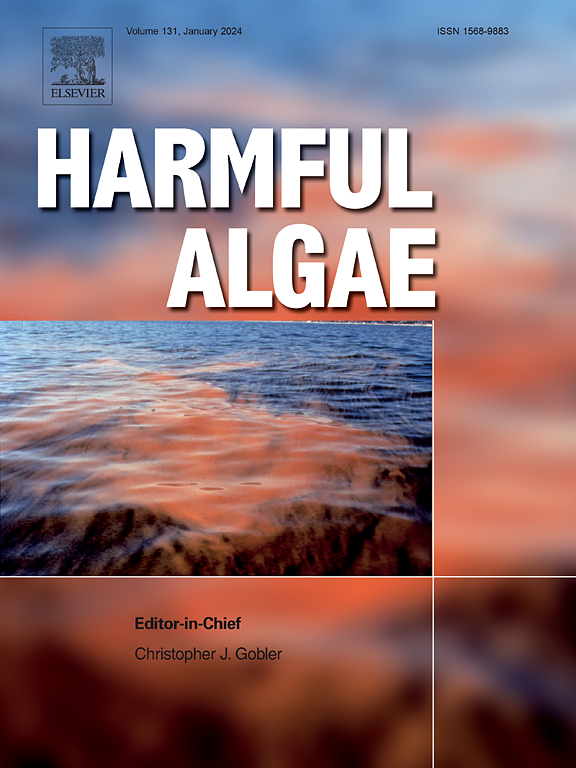Growth enhancement of harmful dinoflagellate Prorocentrum cordatum by bacterial community shifts driven by dissolved organic matter derived from raphidophyte Heterosigma akashiwo
IF 4.5
1区 生物学
Q1 MARINE & FRESHWATER BIOLOGY
引用次数: 0
Abstract
Phytoplankton blooms release dissolved organic matter (DOM), altering the composition of marine environments, which impacts microbial communities. Variation in DOM utilization among bacterial taxa can shift bacterial community structure, potentially affecting phytoplankton growth and species composition. Given the observed bloom successions of Heterosigma akashiwo and Prorocentrum cordatum, we hypothesized that H. akashiwo-derived DOM could influence P. cordatum growth via alterations in the bacterial community. This study investigated how DOM-modified bacterial communities affect P. cordatum growth. Our results showed that P. cordatum growth was enhanced by 76–220 % when exposed to DOM-altered bacterial communities, while Skeletonema costatum growth was suppressed by 24–28 %. This study demonstrates that the ratio of humic-like carbon to fulvic-like carbon in H. akashiwo-derived DOM, particularly during the stationary and decline phases, promotes bacterial taxa capable of degrading high-molecular-weight compounds, thereby facilitating P. cordatum growth. Functional predictions identified specific bacterial taxa with potential growth-promoting effects. Among them, Dokdonia, a genus within the family Flavobacteriaceae, was enriched in DOM-exposed bacterial communities and associated with growth enhancement, whereas algicidal and methanotrophic bacteria were more abundant in the absence of DOM. These findings highlight the role of bloom-phase-specific DOM in shaping bacterial communities and driving phytoplankton bloom succession.
赤石刺藻(Heterosigma akashhiwo)溶出的有机物驱动细菌群落变化对有害鞭毛藻cordatum生长的促进作用
浮游植物大量释放溶解的有机物(DOM),改变海洋环境的组成,从而影响微生物群落。细菌分类群中DOM利用的变化可以改变细菌群落结构,从而可能影响浮游植物的生长和物种组成。根据观察到的赤石异源菌(heterossigma akashiwo)和心珠原菌(proorocentrum cordatum)的开花序列,我们假设赤石异源菌衍生的DOM可能通过改变细菌群落来影响心珠的生长。本研究探讨了dom修饰的细菌群落如何影响猪心草的生长。结果表明,当暴露于dom改变的细菌群落时,P. cordatum的生长增强了76 - 220%,而costatum的生长抑制了24 - 28%。本研究表明,在赤石草衍生的DOM中,腐植酸类碳与黄腐酸类碳的比例,特别是在静止和衰退阶段,促进了细菌分类群能够降解高分子量化合物,从而促进了草的生长。功能预测鉴定出具有潜在生长促进作用的特定细菌类群。其中,黄杆菌科的Dokdonia属在DOM暴露的细菌群落中富集,并与生长促进有关,而在没有DOM的情况下,杀藻菌和甲烷营养菌更丰富。这些发现强调了特定于开花阶段的DOM在塑造细菌群落和驱动浮游植物开花演替中的作用。
本文章由计算机程序翻译,如有差异,请以英文原文为准。
求助全文
约1分钟内获得全文
求助全文
来源期刊

Harmful Algae
生物-海洋与淡水生物学
CiteScore
12.50
自引率
15.20%
发文量
122
审稿时长
7.5 months
期刊介绍:
This journal provides a forum to promote knowledge of harmful microalgae and macroalgae, including cyanobacteria, as well as monitoring, management and control of these organisms.
 求助内容:
求助内容: 应助结果提醒方式:
应助结果提醒方式:


